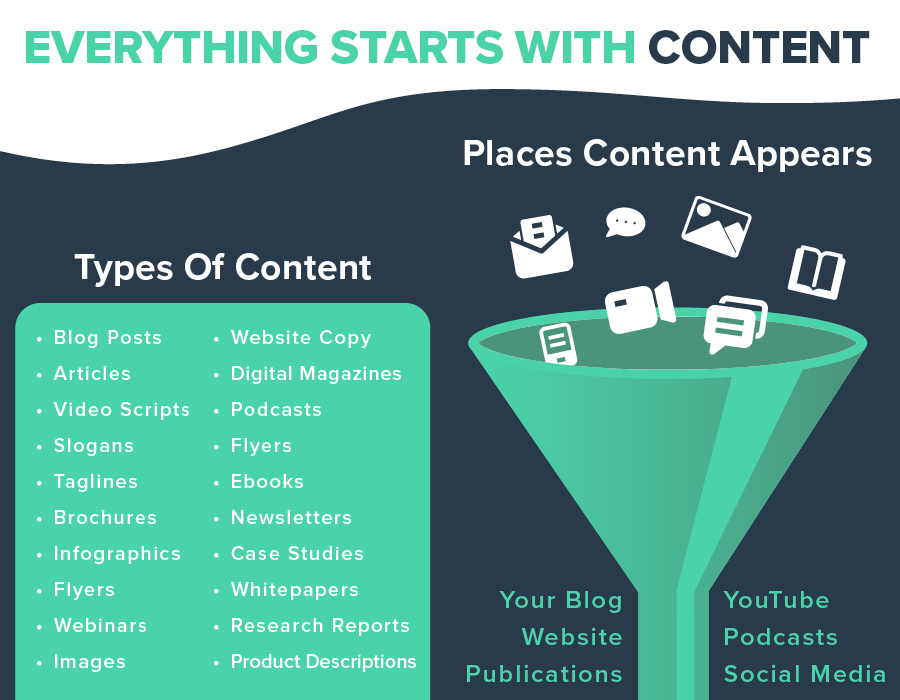A Handy Guide to Content Marketing Lingo

It’s not just the marketing industry — every field has its own jargon, acronyms, and “language.” Knowing what’s what and how to speak the lingo as you move through different contexts and settings is often called “code-switching.”
With so many marketing terms that even agencies and marketers sometimes casually use words or phrases interchangeably, it can be challenging to understand the language well enough to accurately hire for the end product (AKA “deliverable”) you really want.
And if the person assigning the task and the person completing the task are using the same terminology to mean two different things, that’s gonna cost you time and money in the long run. So this blog provides an insider’s dictionary that will help you protect your business budget and better achieve your marketing goals.
What Is “Content Marketing”?
Content Marketing involves strategically planning, creating, and publishing content to promote your company, increase brand awareness, and generate business.
Generally speaking, “content marketing” covers a wide range of tasks that can be boiled down to this basic definition.
However, content marketing is less about explicit product advertising or time-specific promotional materials and more about a focused and concerted effort to attract a particular audience. The point is to engage with potential clients by consistently providing relevant and valuable content in order to build and maintain lasting relationships.
What Does “Content” Mean in Marketing?
In marketing, the term “content” typically refers to both words and images. These images can be any kind of visual element created with software programs (like Adobe InDesign, Canva, or CorelDRAW); they can also be organic or stock photography, video, and so forth.
If we want to be more technical, then instead of saying “content refers to both words and images,” we’d say content usually includes both copy and design. Some people might say that content includes both text and design.
However, people in other industries besides marketing, journalism, and publishing usually think of Xerox when the term “copy” is mentioned. And since the advent of cell phones, most people think of messaging apps when the word “text” is used.
So, if it helps, instead of fancy lingo like copy and text, just think of it as “words” for right now. And in this particular blog, we’re only going to focus on the words-side of “content” — not the visual graphic design part.

But hold on! Don’t just think of “content” as written words requiring readers. Listeners and viewers are still influenced by words, because brand anchor videos or promo vids or podcasts or commercials are all born from scripts AKA words AKA content.
Got it? Great! We’re almost done.
Different Kinds of Digital Content or Print Collateral
Content is super important when it comes to marketing, even though it sometimes gets short shrift because folks are tempted to think they don’t need to hire a pro to write words. Too often, they save their marketing budget for graphic design or web development. After all, business owners and employees speak the language, so they can just write the words themselves!
It’s too simplistic and often a mistake to approach content this way. There are so many different kinds of content — each with its own specialized audience, purpose, tone, and style — that hiring a professional writer or a marketing agency with writers on staff is often the best way to achieve your business goals.

The Difference Between Copywriting and Content Writing
Wait! Don’t confuse “copywrite” with “copyright.” The first term has to do with a professional writing words, and the second term is a legal designation protecting someone’s words as their property.
It’s important to understand the difference between content writing and copywriting, so that you assign the right scope of work (SOW) for your business aims.
Even though some marketers use “copywriting” and “content writing” interchangeably, they are not the same thing and result in different levels of writing for very different deliverables (AKA end products).
| Here’s an Easy, though not exhaustive, infographic to help remember the distinction: | |
| Copywriting | Content Writing |
|---|---|
| Short Form usually requires less time, less research, and different skill set | Long Form usually requires more time, intensive research, and different skill set |
| Promotional materials largely based on information received from the client and primarily used to persuade in one or more of the following ways: generate leads (lead gen), humanize a company, quickly build brand awareness or interest, etc. | Brand-aligned digital or print materials largely based on research that incorporates multiple assets and is primarily used to explain a product or service, share detailed information about the company, build brand trust over time, engage or entertain the target audience, cultivate relationships that result in sales. |
| Examples:
Slogans & Taglines Sales emails Ad copy:
Social media posts
Brief web copy:
|
Examples:
|
Ch-Ch-Ch-Ch-Changes
Similar distinguishing levels as those used in creating content also apply when making changes to the content. Often lumped together as “edits,” there is a difference between revising, editing, and proofing. Each level requires increased time and skill — and cost — so know what you want when hiring or adding these steps to your process cycle.
Revise: Global, big changes to overall direction of content. Example: Instead of writing about metal roofing, we’re going to write about bathroom remodels. Another Example: The client gives the writer a topic and perhaps an outline or rough draft and wants the writer to add new content or cut current content based on credible, relevant research.
Edit: Local, smaller changes that leave the overall direction of content intact and focus on grammar, diction, syntax, and other writing (technical) issues. Example: The original text from the client mixeds past tense and present tense, so the hired writer makes verbs consistent but doesn’t add or cut content.
Proof: Micro level typo corrections that anyone could/would spot and fix if they were in the project loop. (This step is sometimes called “QC” for “quality control.”) Examples: The year is 2022 instead of 2023. The page numbers are off. The word says “god” instead of “dog.”
How to Optimize Content for Search Engines — and More
No matter the type of content being written, it should be optimized for search engines (SEO) and published when and where it makes strategic sense according to market research. Wanna learn more about local SEO strategies? Check out the following articles: Get Found In Local Google Search Results and Stay in the Know About SEO: Upcoming Changes That Will Affect Your Ranking.
And regardless of the type of content you’re writing, it should be compelling, which means it should move the audience to an intended action that serves your overall business objectives. Stay tuned for next month’s blog, “The Six C’s of Compelling Content,” and discover how to ensure your content always hits the mark.
If you need marketing help in the meantime, Liquid Creative is always here.






